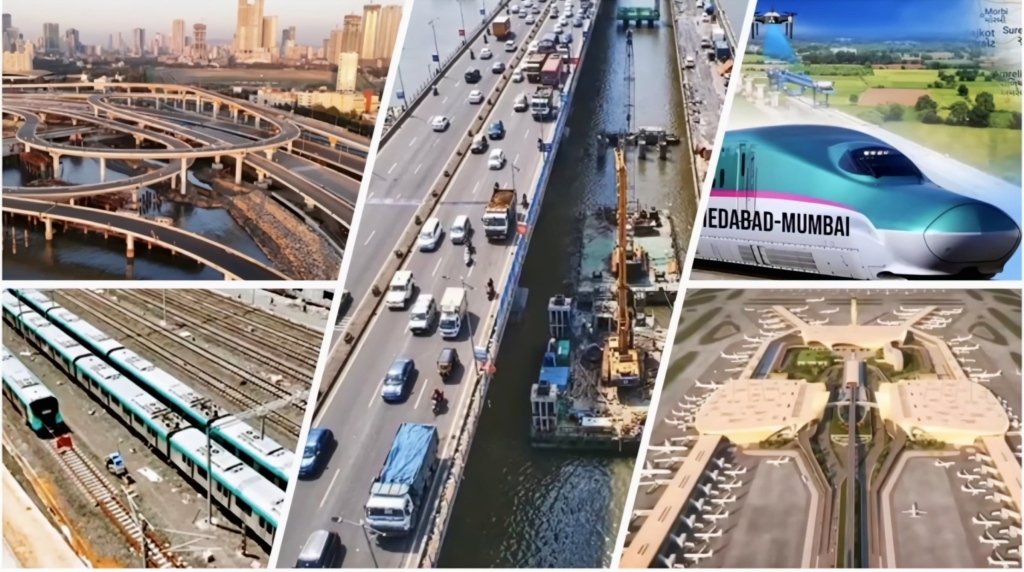Mumbai is going through one of the biggest transformations in its history. With a long list of major infrastructure projects expected to be completed by 2030, the city is evolving fast—much like New York. But unlike New York, where some projects are built without urgent need, Mumbai transformation are necessary.
Why Mumbai Needs a Makeover
Mumbai was once a cluster of seven small islands. In 1950, only 3 million people lived here. Today, over 20 million people call it home—more than the populations of countries like the Netherlands or Romania. This massive population puts huge pressure on the city, especially its roads and public transport.
Most people in Mumbai rely on buses, trains, and the metro. Those who drive get stuck in long traffic jams. A trip that should take 30 minutes can often take 50 because of congestion.
Adding to the problem, the number of vehicles has doubled in the last 10 years. But the city hasn’t been able to build new roads quickly enough—mainly because it’s surrounded by the sea on three sides, which limits space for expansion.
The Game-Changer: Mumbai Coastal Road
To fix this, Mumbai is building a 29-km coastal road. It will run along the city’s western coast from south to north. Right now, only two main highways connect north and south Mumbai. This new road will ease traffic on those highways by carrying up to 130,000 vehicles every day.
The road has two main sections:
- Northern part: From Kandivali to the Bandra-Worli Sea Link
- Southern part: From the Bandra-Worli Sea Link to Princess Street Flyover
But this won’t be just any road. The coastal road will also add 70 hectares of green space and a 7.5-km-long promenade where people can walk, jog, or cycle. The area will feature butterfly parks, open-air theatres, and cycling tracks.
How Will They Build It?
Mumbai is using land reclamation to create more space. This means dumping tons of rock and soil into the sea to make new land—just like Dubai did for its artificial islands.
There will also be two lanes only for buses and many stops to help public transport users. One of the most exciting parts of the project is the underwater tunnel, built under Malabar Hill, which was too steep for a regular road. Engineers used a giant tunnel boring machine called Mavala, weighing 28,000 tons—the largest in India—to dig deep underground.
The road is expected to:
- Cut travel time by 70%
- Reduce fuel use by 34%
The first part of the southern stretch opened in March 2024. In the future, the road will be extended to Versova and maybe even Virar.
Metro Expansion in Mumbai
Traffic isn’t the only thing being improved. Mumbai is also expanding its metro system. Right now, the city has three metro lines covering about 46.5 km. But nine more lines are under construction.
Important Metro Projects:
- Aqua Line (Line 3): Mumbai’s first underground metro with 26 stations. It connects business hubs like Bandra Kurla Complex and the Mumbai Airport. It started running in July 2024 and could carry 1.7 million passengers a day by 2031.
- Orange Line (Line 5): An elevated metro line connecting Thane, Bhiwandi, and Kalyan. It will be 25 km long with 17 stations.
- Pink Line (Line 6): Another elevated line with construction already underway. It’s expected to be partially open by 2025.
Elevated metros are smart because they don’t use up ground space and help ease traffic on main roads.
Fast Trains: Mumbai to Ahmedabad in 2 Hours
Mumbai is also becoming better connected with other cities. A high-speed rail line is being built between Mumbai and Ahmedabad. Right now, over 400,000 people travel between these cities every day.
The new 500-km railway will reduce travel time from 7 hours to just 2 hours. There will be:
- Rapid trains stopping at only two stations
- Regular trains stopping at all 12 stations
India is getting 24 Japanese bullet trains (Shinkansen) for this route. The first section will open by August 2026, and the full project will finish by 2028. Japan is funding most of it with loans.
Mumbai’s New International Airport
To handle the growing number of air travelers, Mumbai is building a brand-new airport in Navi Mumbai, just 35 km from the existing airport.
Designed by the famous Zaha Hadid Architects, the new airport will look like a lotus flower—India’s national symbol. It will have:
- Two runways
- Three terminals
- Capacity for 25 million passengers in Phase 1
- Up to 90 million passengers once fully built
This new airport will be easy to reach by metro, buses, suburban trains, and highways. It’s expected to open by March 2025 and bring in many new businesses, hotels, and shops.
Major Bridges to Connect Mumbai Better
Mumbai Trans Harbour Link
Opened in early 2024, this is India’s longest sea bridge. It connects South Mumbai to Navi Mumbai with a 22-km, six-lane road. Travel time is now just 20 minutes—down from 2 hours! Funded mostly by Japan, the bridge cost about $2.1 billion.
Third Thane Creek Bridge
This bridge will expand the existing route to 12 lanes. Three new lanes are being added on each side. The project faced delays due to environmental concerns, especially over mangroves and fishing areas. Now that legal approvals are in place, it’s moving fast. The first three lanes will open by September 2024, and the rest next year.
Final Thoughts
Mumbai is not just growing; it’s transforming in a big way. With new roads, metro lines, bullet trains, an international airport, and massive bridges, the city is getting ready for the future.
These projects will:
- Improve traffic flow
- Create greener spaces
- Boost public transport
- Connect the city better with the rest of India
If you live in Mumbai, you’ll soon experience faster, smoother travel. And if you’re visiting, you’ll see a modern city ready to welcome the world.

